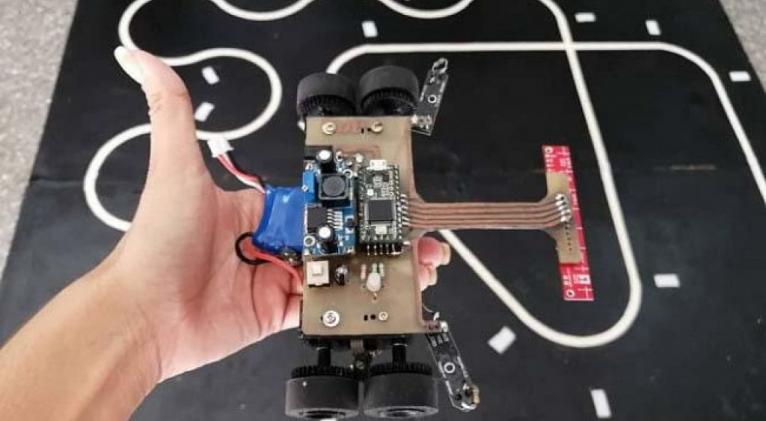Robotics and Automation in Cuban School
especiales

During the evaluation of the educational program implemented in Cuba, President Miguel Díaz-Canel Bermúdez insisted on the importance of the gradual introduction of automation and robotics at different educational levels.
Although these specialties are not new in Cuba, the present goal is to encourage their study and train human capital to interact with machines efficiently.
Automation in Cuba: starting points
The sugar industry pioneered automation in Cuba — in the mid-19th century — by adopting continuous process technologies and of mass production, according to the research «Automation, robotics, and computer systems. Brief History of Automation in Cuba», presented at the 2nd International Scientific Convention of Science, Technology, and Society UCLV 2019.
After the triumph of the Revolution, with the creation of the Ministry of Industries and its Directorate of Automation and Electronics, soon after the Industrial Automation Center — thanks to the forward-looking approach of Che Guevara — this task became a specialty.
First it was the School of Automation (1962), four years later the Department of Automatic Control was created within the Department of Technical Cybernetics of the Academy of Sciences of Cuba and, in that very same year of 1966, the studies of Electrical Engineering introduced the specialty of Regulation and Automatic Control.
Experts from former Czechoslovakia and USSR, taught subjects related to automatic control, first at the University of Havana, the Universidad de Oriente (Eastern University), and later the UCLV (University Marta Abreu of Las Villas).
Robotics in Cuba
In the report on the Working Group for the development of Robotics in Cuba, presented at the 2nd International Scientific Convention of Science, Technology, and Society UCLV 2019, it was pointed out that Robotics in Cuba is characterized by “its poor impact on the improvement of the quality of production and service, productivity growth, energy and raw material savings, humanization of work, and life quality.”
Hence the call of the nation’s leadership to boost the field by identifying, in the first place, those areas that can assimilate faster all the changes, especially on food production, savings, and health.
As a premise, there is the Robotics Development Group, coordinated directly by the Ministry of Higher Education and the UCLV, which will be responsible for sharing expertise with the Technological University of Havana (CUJAE) and the Universidad de Oriente to exchange with technology leaders in search of process automation.
In recent statements to ACN, Doctor of Science Luis Hernandez Santana, professor at UCLV Department of Automatic Control, detailed the expertise of this university in mobile robotics with self-driving, aerial, and water vehicles, inserted in industrial or service processes.
The researcher pointed out that Cuba, in the very short term, can show results in the sugar industry with those equipment with advanced cultivation systems, such as harvesters and fertilizer supply machines that, with a computer on board, can perform automated functions. This work, he said, is a joint effort with the National Sugarcane Research Institute.
Hernández Santana, also a scientific coordinator within the National Group for the Development of Robotics in Cuba, agrees that the current population dynamics on the Island need to automate processes to ease the work of human beings, while still thinking about the development of domestic robotics for the care of the elderly.
In the Technological University of Havana José Antonio Echeverría (CUJAE), the Instrumentation and Control Laboratory, equipped with state-of-the-art technology for the flow measurement — widely used in Cuban petrochemical industry — has been in place for two years now.
CUJAE also ventures into the design of algorithms for mobile robotics aiming at processing images for the avoidance of obstacles, trajectory planning, and the self-assessment of the positioning of robots.
An interesting project linked to health takes place in Santiago de Cuba. There, the Universidad de Oriente develops a prototype robotic exoskeleton that brings in already the first positive results in patients who have the “shoulder pain” condition.
The goal is to be able to use it in the rehabilitation of hemiplegic patients because of a cerebrovascular disease. This is a joint research between the Center for Medical Biophysics of the Universidad de Oriente and the Juan Bruno Zayas Clinic-Surgical Hospital.
Although the nation began working since the 1980s in the automation of processes, the obsolesce of several equipment from the former socialist bloc as well as the high demands set nowadays by international quality standards, constitute conditioning factors for automation and robotics, which continue to pave their ways in the country, especially after that first seed was actually sown in Cuba’s educational system.
It will not only make us more competitive in terms of exports — paramount for our economy — but it will also allow us to place ourselves in the face of the so-called Industry 4.0. Simultaneously, both will play a more decisive role in the humanization of work and both will improve the quality of life of Cubans, who must face the restrictions of the U.S. blockade in this field as well.
Robotics and Automation in the classroom
With the introduction of the subjects Robotics and Automation in different educational levels, the nation looks forward to creating multidisciplinary learning environment.
According to Granma newspaper, the experience gathered in robotics and automation by the Enrique José Varona Pedagogical University, the University of Pinar del Rio, Oriente, UCLV, and CUJAE will be considered.
The goal is that children and teenagers may develop their scientific and engineering intuition, encouraging their research and troubleshooting skills.
Do you imagine kids learning about robotics? Can you picture the change this society may experience? Can you imagine when people start searching another way to solve common problems? The Cuban president asked. We can truly picture that. And it will not be sci-fi, but development, quality of life.
Translated by Sergio A. Paneque Diaz/CubaSi Translation Staff













Add new comment